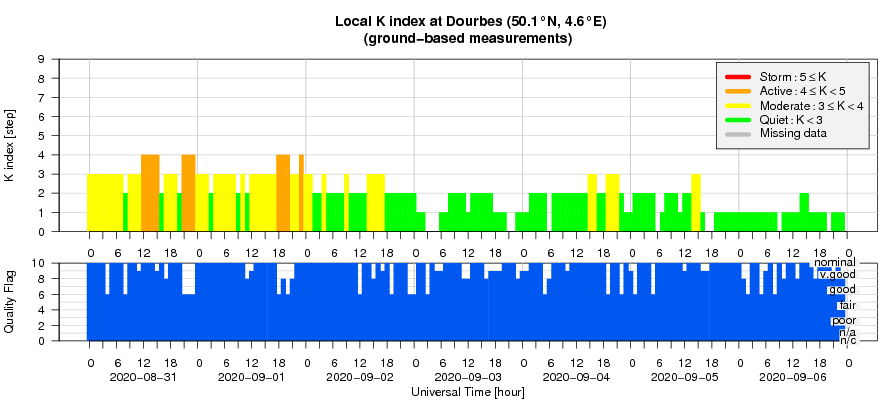- Table of Content
- 1.Adieu filament...
- 2.Review of sola...
- 3.PROBA2 Observa...
- 4.The Internatio...
- 5.Review of geom...
- 6.Geomagnetic Ob...
- 7.The SIDC Space...
- 8.Review of iono...
2. Review of solar activity
3. PROBA2 Observations (31 Aug 2020 - 6 Sep 2020)
4. The International Sunspot Number by Silso (31 Aug 2020 - 6 Sep 2020
5. Review of geomagnetic activity
6. Geomagnetic Observations at Dourbes (31 Aug 2020 - 6 Sep 2020)
7. The SIDC Space Weather Briefing
8. Review of ionospheric activity (31 Aug 2020 - 6 Sep 2020)
Adieu filament!
Solar filaments are clouds of charged particles ("plasma") above the solar surface squeezed between magnetic regions of opposite polarity. Being cooler and denser than the plasma underneath and their surroundings, they appear as dark lines when seen on the solar disk and as bright blobs when seen near the solar limb (then they are called "prominences"). Special filters are required to observe these features, and one such a filter is the Hydrogen-alpha (H-alpha) line in the red part of the solar spectrum.
Long filaments are known to eventually erupt, as the surrounding magnetic fields usually become unstable at some point. Early on 31 August however, magnetic fields around a relatively small filament chunck became unstable, resulting in the eruption of the short filament. No significant x-ray flaring was associated with this event. A weak non-earth directed coronal mass ejection was observed. Some of the material rained back to the solar surface along the magnetic field lines.
The imagery underneath first shows a comparison between H-alpha from the Global H-alpha Network (GONG, ground-based; http://halpha.nso.edu/ ) at relatively cool temperatures of about 10.000 degrees, and in extreme ultraviolet (space based, SDO; https://sdo.gsfc.nasa.gov/ ) at temperatures near 1.25 million degrees. The before and after images clearly show the spectacular absence of the filament. The EUV image also show that the filament was longer than what could be expected from the H-alpha imagery. It is likely that this filament channel was filled for the most part with plasma having a higher temperature, such that it was well visible in EUV (higher temperature filters), but only a small part visible in H-alpha (the part with the "coldest" temperature). Clips of this event are at http://www.stce.be/news/495/welcome.html
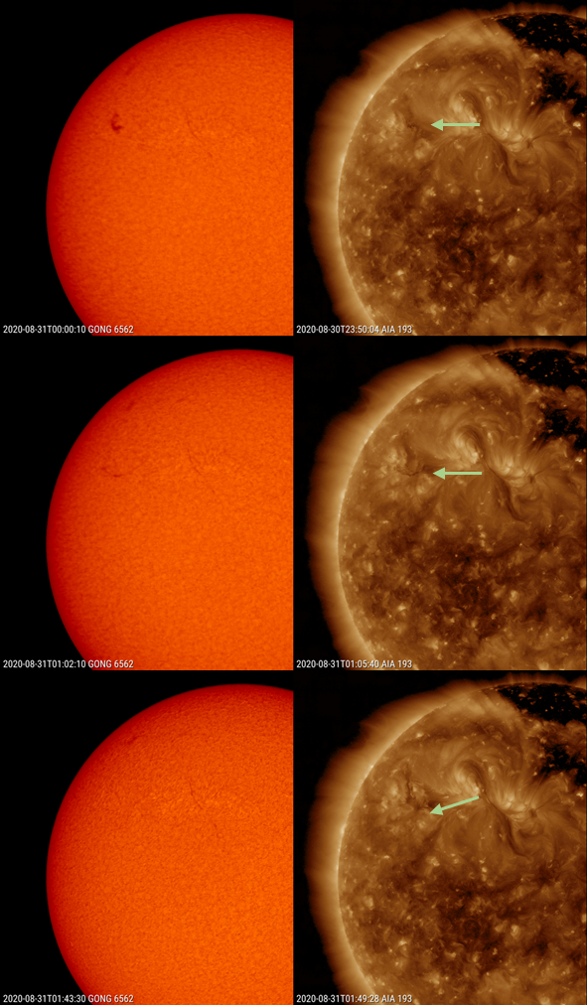
The next view is also in extreme ultraviolet, but at lower temperatures of about 80.000 degrees (SDO/AIA 304) showing much better the filament and the ejected loop-like structure of cold plasma that is being ejected.
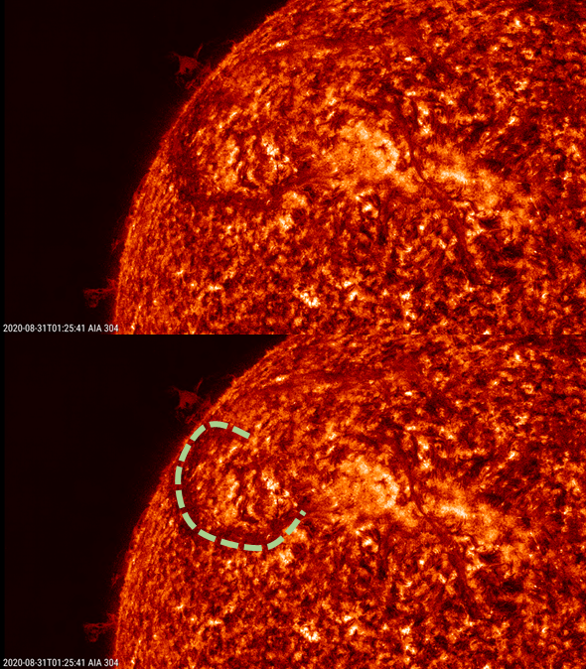
Finally, a view of the event as recorded by the STEREO-A spacecraft (https://stereo-ssc.nascom.nasa.gov/ ), which is at about the same distance from the Sun as the Earth, but trailing the Earth by about 63 degrees. This means that the STEREO-A had a more direct (straight) view on the eruptive area than visible from Earth. Also here, the erupting loop is best visible in the low temperature filters (EUVI 304), whereas the coronal dimmings (transient holes in the corona caused by the ejected material) are better visible in the high temperature EUV filters (EUVI 195). The coronal dimmings are better visible by STEREO-A than SDO because of the better viewing direction.
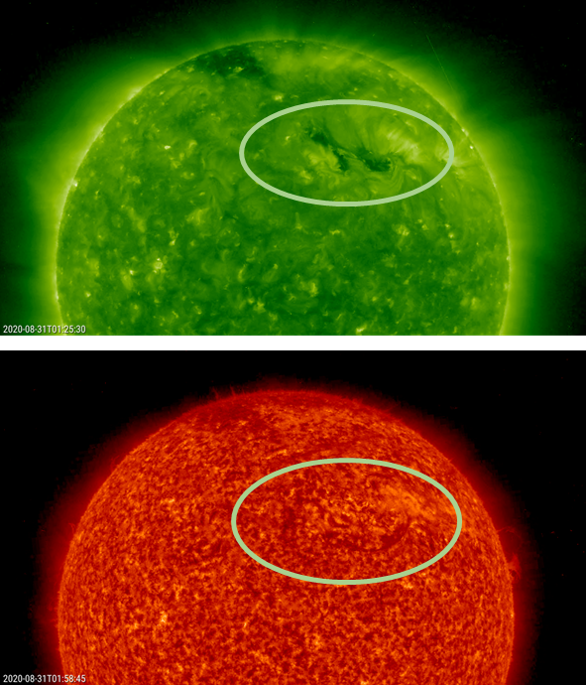
Review of solar activity
Solar activity was at very low levels with the solar X-ray flux below B-level.
No Earth-directed coronal mass ejections were observed.
The greater than 10 MeV proton flux was at background levels.
The greater than 2 MeV electron flux was at moderate to high levels in response to the enhanced solar wind conditions, reaching a maximum value of 29400 pfu at 16:20 UT Sep 02.
PROBA2 Observations (31 Aug 2020 - 6 Sep 2020)
Solar Activity
Solar flare activity was very low during the week.
In order to view the activity of this week in more detail, we suggest to go to the following website from which all the daily (normal and difference) movies can be accessed: https://proba2.oma.be/ssa
This page also lists the recorded flaring events.
A weekly overview movie can be found here (SWAP week 545). http://proba2.oma.be/swap/data/mpg/movies/weekly_movies/weekly_movie_2020_08_31.mp4
Details about some of this week's events can be found further below.
If any of the linked movies are unavailable they can be found in the P2SC movie repository here https://proba2.oma.be/swap/data/mpg/movies/
Monday Aug 31
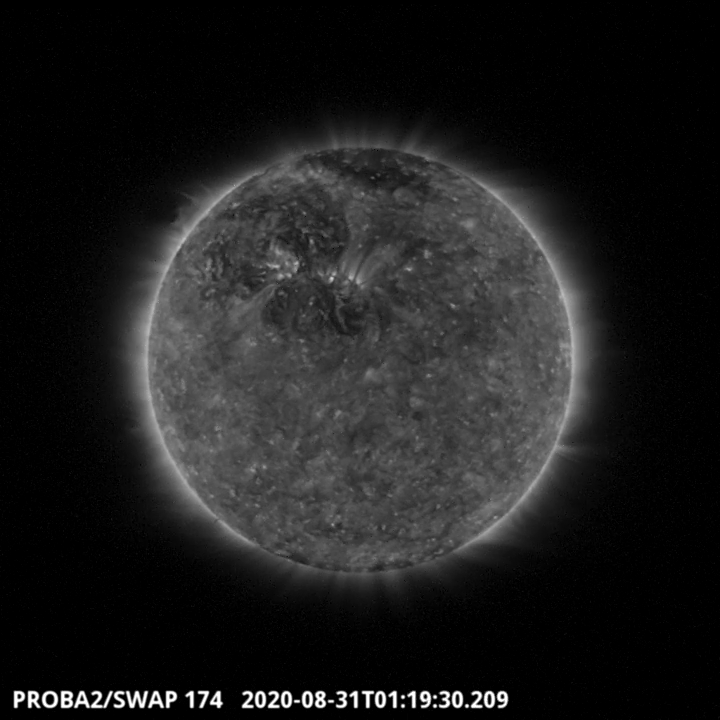
A Filament Eruption on North-East quadrant of the Sun around 01:19 UT - SWAP image. Find a movie of the event here (SWAP movie) http://proba2.oma.be/swap/data/mpg/movies/20200831_swap_movie.mp4
The International Sunspot Number by Silso (31 Aug 2020 - 6 Sep 2020
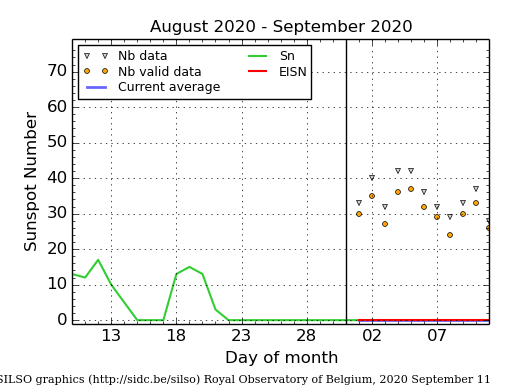
The daily Estimated International Sunspot Number (EISN, red curve with shaded error) derived by a simplified method from real-time data from the worldwide SILSO network. It extends the official Sunspot Number from the full processing of the preceding month (green line). The plot shows the last 30 days (about one solar rotation). The horizontal blue line shows the current monthly average. The yellow dots gives the number of stations that provided valid data. Valid data are used to calculate the EISN. The triangle gives the number of stations providing data. When a triangle and a yellow dot coincide, it means that all the data is used to calculate the EISN of that day.
Review of geomagnetic activity
The solar wind parameters were enhanced at the start of the week due to the influence of the positive polarity coronal hole that crossed central meridian on August 28.
The solar wind speed was around 500 km/s at the start of the week and increased from Aug 31 to Sep 01, reaching a maximum value of around 640 km/s on Sep 01. The speed then slowly decreased over the rest of the week to values just less than 400 km/s on Sep 06.
The total magnetic field ranged between 0 and 9 nT and Bz had a minimum value of -7 nT. The interplanetary magnetic field (phi angle) was predominantly directed away from the Sun (positive sector).
Geomagnetic conditions reached active to minor storm levels (NOAA Kp 3-5 and local K Dourbes 2-4) on Aug 31 to Sep 01 due to the influence of the high-speed stream from the positive polarity coronal hole.
From Sep 02 to Sep 06 geomagnetic conditions became mostly quiet with a few unsettled intervals (NOAA Kp and local K Dourbes 0-3) in response to the decreasing solar wind speed.
The SIDC Space Weather Briefing
The Space Weather Briefing presented by the forecaster on duty from August 30 to September 6. It reflects in images and graphs what is written in the Solar and Geomagnetic Activity report.

The pdf-version: http://www.stce.be/briefings/20200907_SWbriefing.pdf
The movie: http://www.stce.be/briefings/20200907_SWbriefing.m4v
Review of ionospheric activity (31 Aug 2020 - 6 Sep 2020)
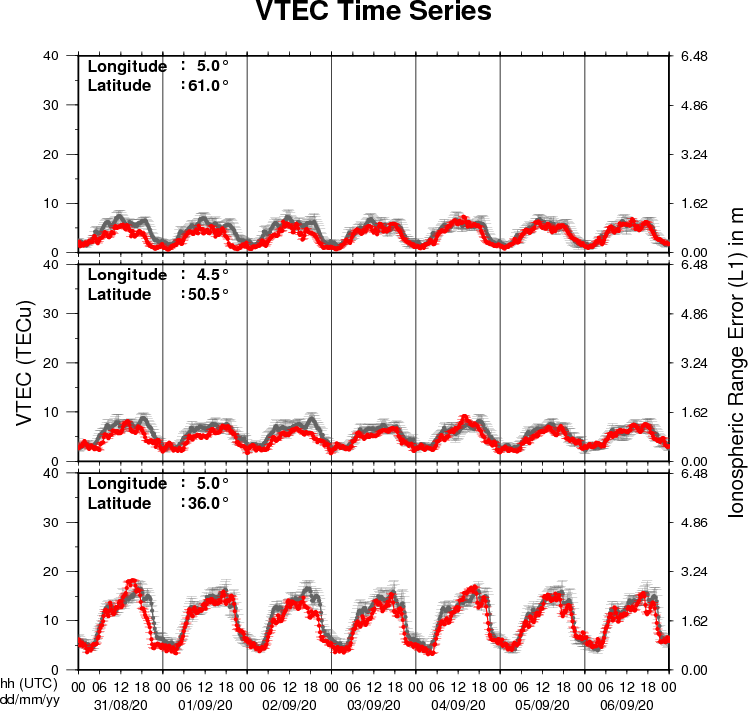
The figure shows the time evolution of the Vertical Total Electron Content (VTEC) (in red) during the last week at three locations:
a) in the northern part of Europe(N61°, 5°E)
b) above Brussels(N50.5°, 4.5°E)
c) in the southern part of Europe(N36°, 5°E)
This figure also shows (in grey) the normal ionospheric behaviour expected based on the median VTEC from the 15 previous days.
The VTEC is expressed in TECu (with TECu=10^16 electrons per square meter) and is directly related to the signal propagation delay due to the ionosphere (in figure: delay on GPS L1 frequency).
The Sun's radiation ionizes the Earth's upper atmosphere, the ionosphere, located from about 60km to 1000km above the Earth's surface.The ionization process in the ionosphere produces ions and free electrons. These electrons perturb the propagation of the GNSS (Global Navigation Satellite System) signals by inducing a so-called ionospheric delay.
See http://stce.be/newsletter/GNSS_final.pdf for some more explanations ; for detailed information, see http://gnss.be/ionosphere_tutorial.php
